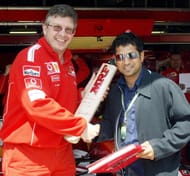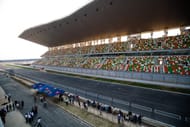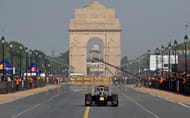Formula One isn’t a sport for everyone. Well, quite literally, as quite a few sections in the society have raised a question regarding F1′s status as a ‘sport’.
Motorsport enthusiasts, however, will immediately take a stand as to how F1 is not just a sport, but maybe even more. Either way, F1 has been an incredibly major part of our life, even in India, with every driver flirting with the speed limit being labeled ‘Schumacher’.
The Schumacher effect
Now even though a majority of the unsuspecting public still believes that Ferrari can easily pip everyone else on the track and F1 is only an exhibition of how quickly the team in red can do it, there is a small faithful following that is paving the path for greater understanding and popularity.
No longer does F1 fall in the bracket of ‘cars going round and round, till one of them wins, and then they shift to another locale’. The only reason Michael Schumacher rolls off the tongue so easily is probably because his name was once synonymous with the sport, and India were only beginning to peep into that arena, and the seven-time world Formula One racing champion probably caught their eye.
Anchored by the Little Master
Schumacher’s association with Ferrari also contributed to this simplistic view, because clearly the Ferrari, in any shape of form, captures our imagination. They are fast, and are an aspirational version of our daily ride.
The third reason Schumacher and Ferrari are such household names is because they figured in the same sentence as Sachin Tendulkar. The fact that Schumacher and Ferrari are the Little Master’s favourite, adds impetus to the argument.
When Fiat decided to gift a prancing horse to the Indian phenomenon, back in 2002, the little hitch of customs duty made its way into the anchor story of major newspapers. Handed over by Schumacher after he equaled the record of 29 Test centuries by Australian legend Don Bradman, Tendulkar has since sold the Ferrari 360 Modena to a Surat businessman.
The controversy boiled over, and all that remained was a reinforcement of the lavish Formula One culture.
Building a home for F1 in India
Multiple efforts have been made over the years, to promote Formula One in the country, but where alarming numbers still struggle to manage two square meals a day, the irony is just a slap away.
As far back as 1997, a plan was in place to locate the Indian Grand Prix in Kolkata. Fast forward to 2003, and India still had only two permanent raceways to boast of, in Chennai and Coimbatore. Locations near Bangalore, Hyderabad and even Mumbai were reserved to host a track.
Bernie Ecclestone had expressed hope how he expected India to play host by 2007, but that didn’t work out after Mumbai did a volte face, and decided to look at ‘more important matters than car fumes’. Newer sites were explored, including Gurgaon and Haryana.
Finally, in 2007, the Indian Olympic Association zeroed in on the Buddh International Circuit in Greater Noida. And in 2011, India hosted its first ever Formula One race, which was won by Sebastian Vettel of Red Bull-Renault. Not surprisingly, Sachin Tendulkar waved the chequered flag, making for spectacular localised photo content.
On a positive note, the Buddh International circuit created jobs for over 10,000 people, with a potential $170 million in future revenue. Multiple tie-ups and endorsements later, the track is becoming a hot property for road shows.
Even the headliner Auto Expo has been deposed from Pragati Maidan in Delhi, to Greater Noida for its 2014 edition. Even though this was done to avoid the clash with the Detroit Auto Show, and also due to the unavailability of the previous premises in February, it reinforces the idea of a home for auto, in or around the home of Formula One.
Inroads by drivers and sponsors
Drivers have been the biggest ambassadors of the sport in India, with many of them making the trip to gently push the agenda of their sponsor, and eventually the sport.
Back in 2008, Renault came down for a demonstration of their machine and toured all the locations that were in the shortlist for the eventual track, excluding Mumbai. They followed it up by a demonstration at Rajpath, New Delhi, with Nelson Piquet Junior at the wheel. Again, the Public Relations machinery was in full swing with pictures flooding the media of the Renault with the effectual India Gate in the background.
Sponsors Vodafone then took a McLaren machine to Lucknow. Double world champion Mika Hakkinen had expresses his interest in an Indian edition, sparking conversations in the media.
This was followed up by with a Red Bull stunt, and David Coulthard drove his Toro Rosso STR1 on Mumbai streets. His drive across the majestic Bandra Worli sea-link made the papers for all the wrong reasons, after he blew the speed limit of 100 kmph out the water, reaching speeds almost double the allowed range.
Lewis Hamilton made the trip for Vodafone too, showing off his MP4-27 McLaren Mercedes at the Bandra Kurla complex in Mumbai. An interesting point to note here was that how sponsors concentrated on Mumbai, the same city which had shrugged its shoulders earlier.
A long and tricky track
Even though F1 now has an Indian addition to its calendar, Formula One is still far from becoming a sport of choice here. 2 races down, both won by Vettel, India’s only connection to the sport remains in the form of Force India Team Principle Vijay Mallya. Mr. Mallya is a revered businessman, but his recent lows with his airlines business have had an adverse effect on his standing.
In a country obsessed with cricket, even bigger sports like football find it hard to find a foothold. Formula One, with its technicalities and jargon is condemned to remain a sport for the few, unless the public can take unprecedented interest in motorsports and pull themselves up for the challenge.
The impression of being a rich sport will always work against it, and there is not much that the FIA can do about it. Anyway, Jet Black parties are invitation only.




